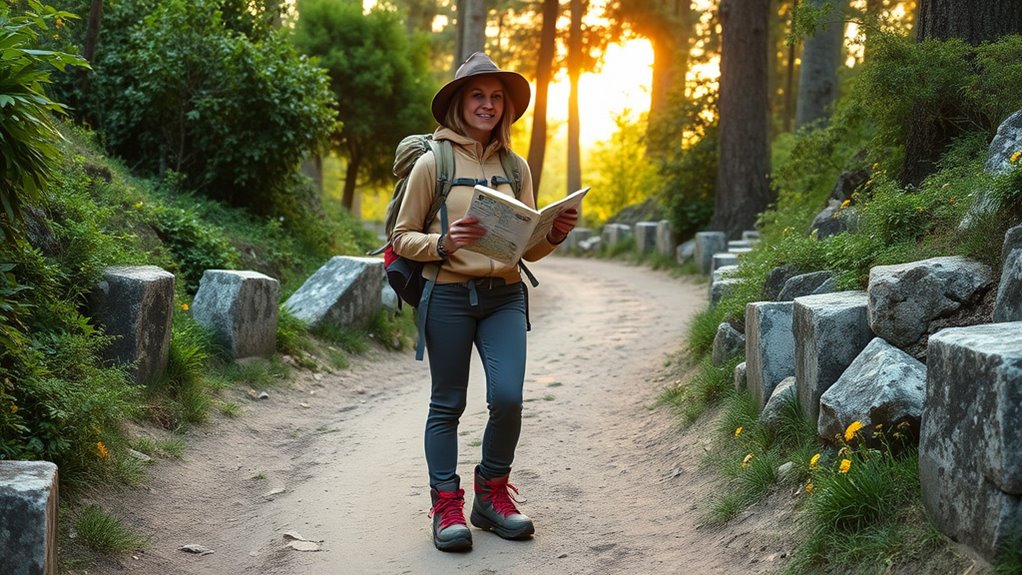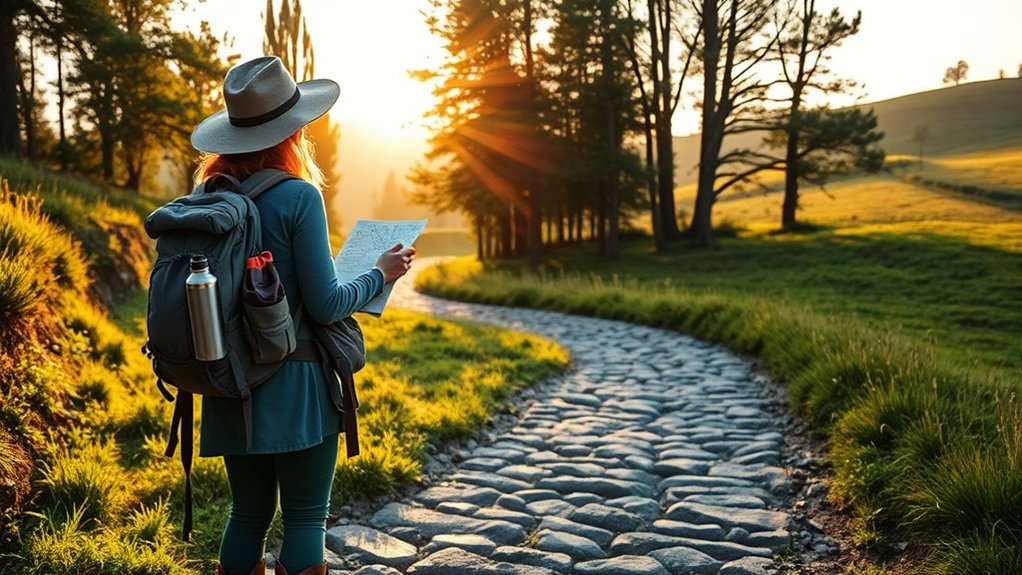To prepare for the Camino de Santiago, plan your route, gather essential gear like sturdy shoes and layered clothing, and book accommodations in advance during peak seasons. Embrace the spiritual traditions, like greeting fellow pilgrims with “Buen Camino” and carrying a scallop shell. Stay nourished, rest well, and use trail markers for navigation. Maintaining an open heart and proper planning will help make your journey memorable—discover more tips and insights along the way.
Key Takeaways
- Plan your start point, daily distances, and accommodations in advance, especially during peak seasons.
- Pack lightweight, weather-appropriate clothing, sturdy shoes, water, and essential supplies for comfort and safety.
- Carry a pilgrim badge like a scallop shell and engage with traditions such as greeting fellow pilgrims with “Buen Camino.”
- Use trail markers, signage, and navigation apps to stay on course across varied terrains.
- Embrace the spiritual aspects by beginning with reflection, respecting the route’s legacy, and fostering community along the way.

Have you ever wondered what it’s like to walk a centuries-old pilgrimage route that combines history, spirituality, and breathtaking scenery? The Camino de Santiago offers a powerful experience, but before you lace up your boots, it’s essential to understand the pilgrimage traditions and trail logistics that shape this journey. Knowing these aspects helps you prepare both mentally and physically, ensuring your walk is fulfilling and manageable.
Pilgrimage traditions are deeply rooted in the Camino experience. Many pilgrims carry a scallop shell, a symbol of the route, and wear it as a badge of honor. It’s customary to start with a prayer or reflection, setting a spiritual tone for the walk. As you traverse villages and historic sites, you’ll notice fellow pilgrims greeting each other with “Buen Camino,” fostering a sense of community. Some choose to carry a small stone or personal item to leave at symbolic sites along the trail, connecting their journey to centuries of history. Respect for these traditions enriches your experience, grounding you in the Camino’s spiritual legacy.
Trail logistics are equally important to contemplate. The route spans roughly 500 miles, crossing varied terrains—flat plains, rugged mountains, and forested paths. Planning your daily distances depends on your fitness level, but most pilgrims walk between 10 to 20 miles a day. It’s wise to choose your start point and stages in advance, especially if you plan to stay in albergues (pilgrim hostels), which fill quickly during peak seasons. Carrying the right gear is crucial: lightweight clothing, sturdy hiking shoes, a hat, and a water bottle are essentials. Weather can change swiftly, so pack layers and rain protection. Also, familiarize yourself with trail markers and signage, which guide you along the route and prevent you from getting lost. Many pilgrims use guidebooks or smartphone apps to navigate and keep track of their progress. Additionally, understanding the importance of shifting gears smoothly on a gravel bike can be valuable if you plan to incorporate cycling into your pilgrimage or explore nearby routes, ensuring a safer and more efficient experience.
Logistics extend beyond the trail itself. Booking accommodations ahead during busy months saves stress. Local cafes and shops along the route provide nourishment, but it’s smart to carry some snacks and a small first aid kit. Communicating with fellow pilgrims can offer support, advice, and camaraderie, making the journey more enjoyable. Remember, the Camino isn’t just about walking; it’s about embracing the rhythm of the trail, respecting the pilgrimage traditions, and staying prepared for the logistical challenges that come with a long-distance trek. With a bit of planning and an open heart, your Camino experience will be as transformative as it is unforgettable.
Frequently Asked Questions
What Is the Best Time of Year to Walk the Camino?
The best time to walk the Camino de Santiago is in late spring (May to June) or early fall (September to October). During these months, you’ll enjoy mild, pleasant weather and avoid the extreme heat of summer, plus the crowd levels are more manageable. Seasonal weather is ideal, with fewer rain showers and comfortable temperatures, making your pilgrimage more enjoyable and less crowded than peak summer months.
Do I Need Prior Hiking Experience to Complete the Camino?
You don’t need prior hiking experience to complete the Camino, but having good physical fitness helps. Did you know that over 70% of pilgrims walk the route for spiritual reasons rather than athletic achievement? With proper preparation, you can gradually build your stamina and learn essential hiking skills. The Camino welcomes all levels, so start training early, stay consistent, and listen to your body to enjoy a rewarding journey.
How Do I Handle Language Barriers Along the Route?
To handle translation challenges along the route, learn some basic phrases in Spanish like “hello,” “thank you,” and “help.” Carry a phrasebook or use translation apps to bridge communication gaps. Smile and be patient—most locals appreciate your effort. Gestures and a friendly attitude go a long way in overcoming language barriers, making your journey smoother and more enjoyable.
Are There Options for Shorter or Alternative Routes?
Yes, you can choose from alternative routes and shorter camino options that suit your pace and schedule. Many pilgrims opt for variations like the Coastal Route or the Primitive Way, which are less crowded and more manageable in length. These shorter camino options still offer a meaningful experience, allowing you to enjoy the scenery and culture without committing to the full route. Planning ahead helps guarantee a fulfilling journey.
What Are the Safety Considerations While Walking the Camino?
Stay safe on your journey by paying close attention to pilgrim safety and route hazards. Always walk with awareness, watch for weather changes, and wear sturdy footwear. Carry essentials like water, a map, and a first aid kit. Avoid risky shortcuts, stay on marked trails, and inform someone of your plans. Precaution and preparation safeguard you from potential perils and ensure a peaceful, pleasurable pilgrimage along the picturesque path.
Conclusion
As you walk the Camino de Santiago, think of it as a journey through a living storybook, each step revealing a new chapter. I once met a pilgrim whose worn-out boots echoed his journey’s hardships, yet they carried him closer to his goal. Remember, every step you take shapes your adventure. Embrace the challenges and cherish the moments—they make your pilgrimage a memorable masterpiece, just like the countless stories woven into the Camino’s timeless tapestry.









